
I’ve been an early adopter of Bluetooth head/earphones dating back to the original Jaybirds Bluebuds X as I simply couldn’t deal with the constant snagging of my earphones on the bus seats or fellow passengers limbs, bags, etc. on my daily commute. Given the decent sound quality (I’m not an audiophile by any means) I was quite content. However, as I expanded BT applications beyond just listening to music, I found the lag was a bit distracting at times while watching videos.
Once apt-X LL was released, I was intent on testing the reduced latency feature. My first foray into this was Avantree’s Audition Pro paired with their Priya II and there was definitely a noticeable improvement latency-wise, however the sound profile wasn’t totally to my liking so next up was Plantronic’s Back Beat Pro which I liked quite a bit. Based on memory, it had everything I liked about the original Backbeat and this time around, they are circumauraul (albeit just barely).
Not long after I purchased the BB Pro, Mixcder offered an opportunity to review their newly released HD601 of which this review covers with a focus on the Low Latency aspect.
PACKAGING & ACCESSORIES
The HD601 comes in pretty typical packaging; it arrived nestled in a plastic inner shell for protection with an outer cardboard sleeve:
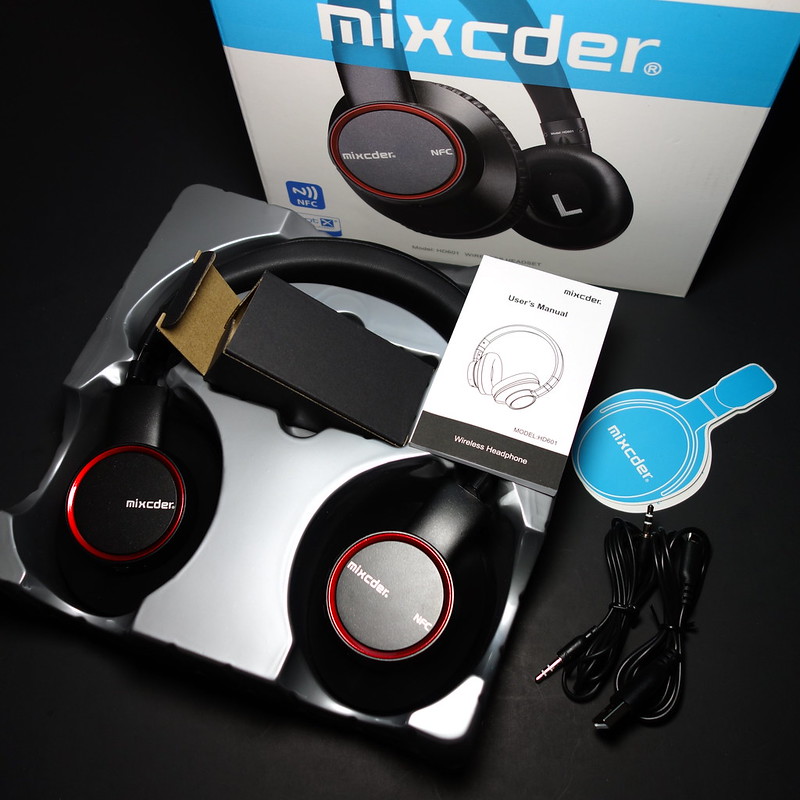
Accessories include: User’s Manual (which is well written in decent English, no “Engrish” here), micro USB cable, 3.5mm audio cable, registration card (for extended warranty).
SPECIFICATIONS
Here are the specs as published by Mixcder:

DESIGN & FEATURES
The HD601 follows a pretty typical cookie cutter template as it comes to styling; that is, it should be instantly familiar to anyone who has ever used a Bluetooth headphone.
All the controls are on the right cup with each button serving multi-functions:
- power button (also used for pairing and play/pause, answer/hang-up, extra bass toggle)
- Vol + (or next track by pressing and holding)
- Vol – (or prev track by pressing and holding)
The microphone, 3.5mm jack and LED indicator are also housed on the right side. This particular LED is used to indicate pairing and codec in use.
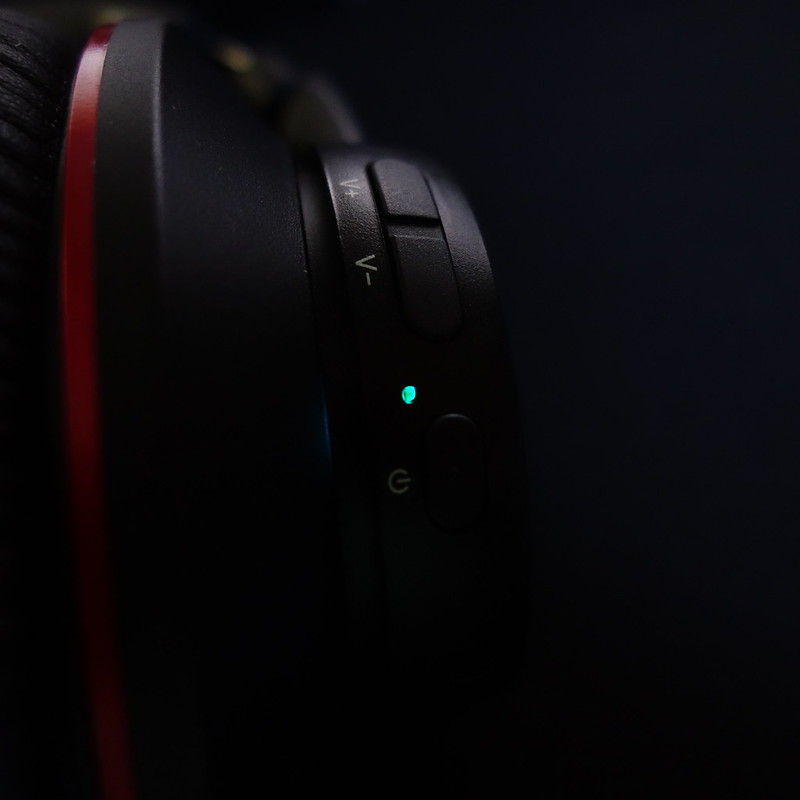
Of note is that when connected to my iPhone, the volume controls are direct (you will see the volume change up and down on your screen with each button press). This isn’t the case with my Asus Zenfone (Android) in that the volume controls run independent of the one shown on the device. One will need to remember to set the volume on the HD601 to max and then control the volume on the device or vice versa. When paired with a BT Tx like Mixcder’s TR008 and using an analog source, I generally like to keep the headphone volume lower and the Tx source louder to prevent drop outs during quiet passages (this won’t occur with a digital source but I digress…).
The left cup features the micro-USB charging port and an LED dedicated solely as the charging indicator:

Both LED’s are well positioned so that they are well recessed within the hole and aren’t obnoxiously bright. I recall there was an old BT headphone I had (forgot which) but the LED was positioned to face forward and was really annoying with dark adapted eyes.
Each cup can be extended a total of 25mm length as indicated in 5mm increments on the steel bands:
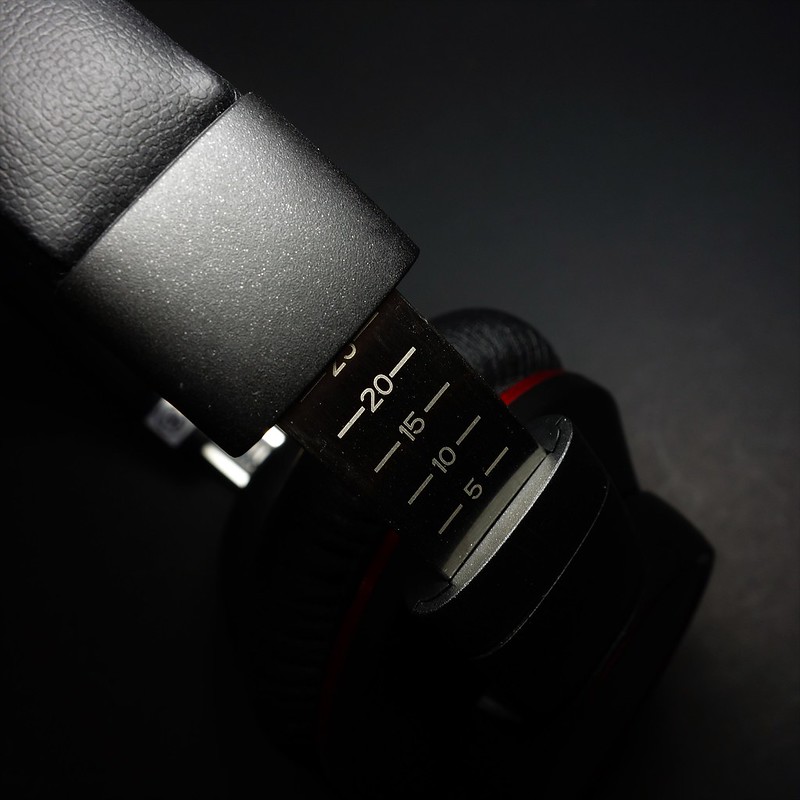
However, the detents are actually at about 3.5mm intervals for a total of seven positions. They are solid enough and won’t accidentally slip between detents even when walking briskly.
The cups can be folded flat so that they face up towards your face when hung around the neck.
They can also swivel about 20 degrees the other way (with the front of the cups angled towards the nose when worn) for additional adjustment:
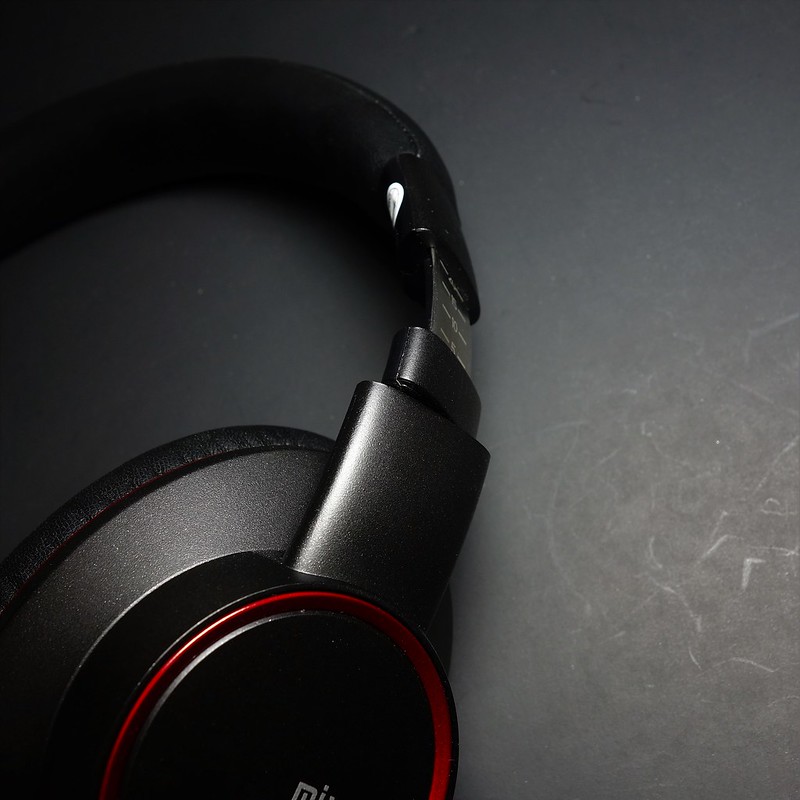
However, I feel that it’s far more important for cups to be able to swivel to follow the natural taper towards the rear of ones’ head. I’ve never understood why certain headphones don’t allow this.
Last but not least, the cups can also be articulated roughly 3 degrees on the Y-axis when worn to provide further adjustability.
Extra Bass (via Power button)
The extra bass feature is “hidden” given it’s activated by the power button and there is no label to indicate its multi-functionality capability. A quick double-press will either activate or deactivate it with no audio or visual cues save for the sudden and pronounced increase / decrease in bass and will retain this setting even after shut-off or when you pair it with another device.
COMFORT
Sadly, I’ve sold some great sounding BT cans due to the lack of comfort. Amongst those were Pendulumic’s Stance S1+ and ME’s Matrix 2 (which by memory are two of the best sounding BT cans I’ve owned). Subjectively, the HD601’s offer a great, comfortable fit overall as the cups can fully accommodate my ears (with lobes). The inner dimensions of the pads are 58.5mm x 38mm (2.3” x 1.49”):

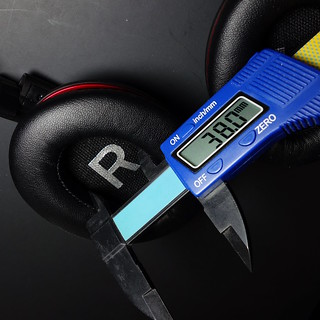
As mentioned in the Design section, the ability for the cups to swivel towards the rear of ones’ head allows it to form a good seal around my ears that contributes to pretty decent noise isolation as well as reduced sound leakage.
The angled driver provides even more space for the helix so that it doesn’t touch the felt within the cup but due to some weird condition, I find that my left lobe has a problem with a few headphones without enough clearance:
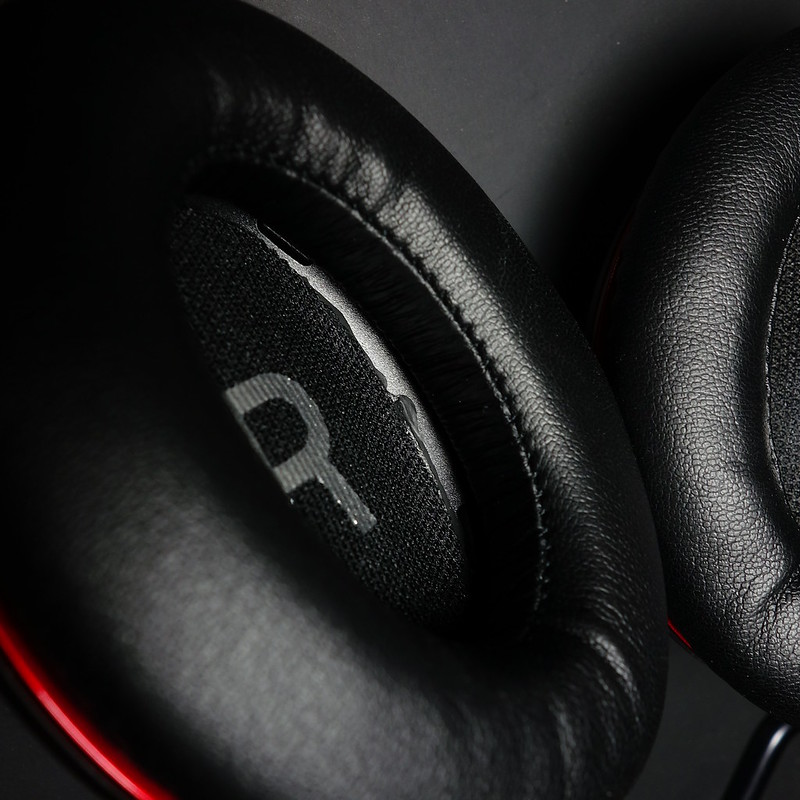
I did experience discomfort with the HD601 as well in this regard but the great thing is that if I adjust the swivel properly the problem goes away.
The clamping force is decent without being overbearing. They stayed in position even when I shook my head vigorously sideways or while tilted fore/aft and also remained in place while doing burpees.
The light weight and decent foam cushions in the pads create a good level of comfort during long listening sessions though heat can be an issue especially in higher ambient temps. I do anticipate them to make great ear muffs which I look forward to testing with the cooling weather here.
BATTERY LIFE / CHARGING
In spurts of listening at moderate volume over the course of a few days, I do find the 15hrs quoted by the manufacturer to be about right. Once battery is sufficiently low, the red LED indicator in right cup will start flashing; furthermore a multi-note tone will sound a few times at roughly 5 minute intervals before the HD601 would just completely shut down.
A charge from fully empty takes a little over 1.5hrs. While charging the red LED charging indicator in the left cup will remain on and shut off once charging is complete. The great news is that when the battery runs down, you have two choices to continue listening to your jams but with the caveat that both involve the use of a wire:
The first is that the HD601 can actually be used while charging in which case you just need to simply plug-in the supplied charging cable to a power source of your choice with the added bonus that you’ll be able to continue to use the extra bass feature. It however cannot be used as an USB headphone as the port is strictly for charging even if you use a proper data capable cable. Of course, charging time will increase slightly (I haven’t measured exactly how long) but at least the tunes won’t have to stop.
The second is to use the supplied headphone cable and listen in passive mode (powered off albeit extra bass won’t be available this way).
PAIRING / CONNECTIVITY / RANGE
Pairing is easily achieved by pressing and holding the power button from an off state for about 5 seconds. An audio cue is provided by a female voice: “Ready to pair, turn on Bluetooth. Pin code is 0000”. The LED indicator in the right cup will alternatively flash blue and red. You should see Mixcder HD601 on your smart device:
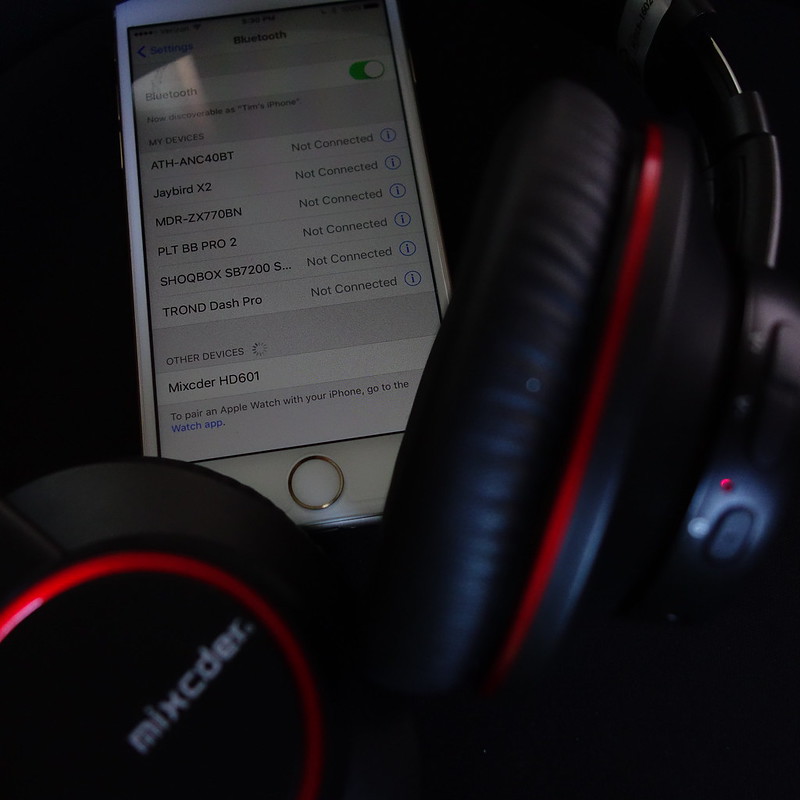
Once pairing is completed, the voice prompt states “Pairing complete, connected.” and the LED indicator stays on solid blue (if this LED is ever flashing blue then it means it’s not connected to a device).
Though not documented, in my time spent with the HD601, I’ve determined that there are additional LED’s (in right cup) that indicates the codec being used but since the Blue LED is constantly on the color is more like what’s in parentheses:
- Blue – SBC
- Red (purple) - aptX
- Green (aqua) – aptX LL
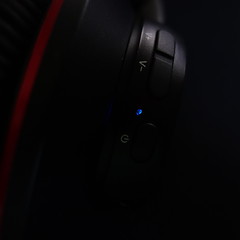


The HD601 features BT v4.2 via the CSR 64215 module and a key benefit over v4.1 is that there’s reduced interference with 4G LTE. I am able to roam to a little over the claimed max range of 10m (even though not line of sight) before it’ll start dropping out while connected to my Asus ZenFone Laser and with a door in between. This ranks as one of the best in terms of range but just slightly behind a Class 1 device like the Backbeat Pro 2.
In my testing, I deduced that the antenna is likely in the right cup since standing right at the point before it starts cutting out, if I turned so that the right cup was further away from my phone, the interference was much stronger.
The only major feature that I wish the HD601 had was multi-point support as I do switch often between my phone and their TR008 which I use with my PC in Tx mode. As a result, I’ve had to re-pair between it and my phone each time I switch between them.
However, there is a semi-workaround if you really need to use two sources, jut that it’ll involve using the headphone cable. Unlike most BT cans, the HD601’s BT circuity will continue to function even if the headphone cable is plugged in. So the trick is to connect to your first source via BT, then to connect to your second source via the headphone cable. You can actually play both sources at the same time but if the BT stream is on, the headphone line will be much lower in volume. Once the BT stream is paused/stopped, after about 23 seconds, the headphone line will return back to full volume (again with caveat that the extra bass feature isn’t available in passive mode despite the HD601 being powered on). It’s a hack to use it this way but at least it’s possible and hopefully a future version will support this.
I don't currently have any devices that support NFC so can't comment on that feature.
aptX Low Latency
I’m currently using their TR008 with my PC with the following routing: PC (via USB) > Soundblaster E5 (via headphone) > TR008 and Priva II (via Monoprice splitter):

I’ve connected the second headphone line from the SB E5 to my speakers so I’m actually able to listen to both at the same time. This allows me to clearly distinguish any latency between BT cans and the speakers. While watching videos, the latency was negligible. It’s only because of my setup that I was able to discern an ever so slight delay as opposed to listening to my speakers. Without the speakers playing as well, I can barely discern any mismatches as spoken words are matched to their actor’s voices perfectly and not once did I feel I was watching a badly dubbed kung-fu movie. A quick test in an FPS like Overwatch yielded the same results of just about no discernable lag. This was about par when compared to BB Pro 2 as well as the Audition Pro.
Beyond this, another application is to utilize the TR008 in Tx mode hooked to headphone output of my DSLR so I can monitor my recordings using BT cans:
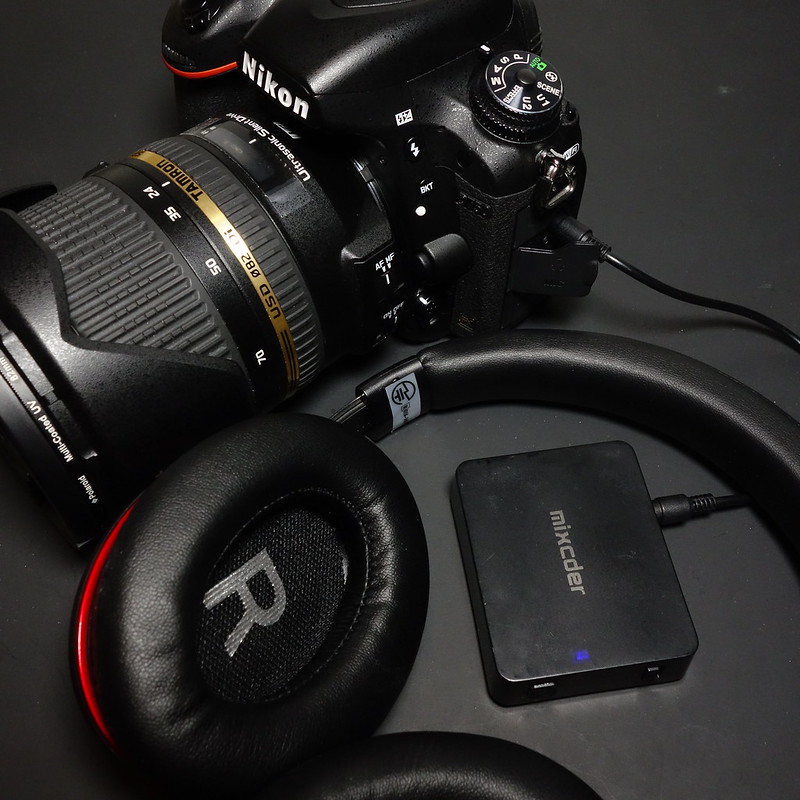
This gives me great freedom to roam away from the camera without fear of accidentally yanking it to its destruction on a tripod while filming.
SOUND
At first listen, one wouldn’t be wrong to call the HD601 a dark headphone but upon a more extended listening session, it becomes obvious why. Even with the extra bass feature off, there is no denying its presence or impact which unfortunately does bleed a bit into the mids and somewhat obscures the treble. Though I’m not a basshead, I’d imagine that the extra bass feature should delight those who are. On “Brothers” (by Tanline), the crisp finger snaps are dull and the pulsing bass line that starts @ :20 sounds bloated. The bass also features prominently at the start of Chris Tomlin’s/Phil Wickham’s track “Thank you God for saving me”, the guitar strums which are normally very crisp take on a dullish sound.
The mids are a bit forward and should delight those into female vocals provided the track doesn’t have a heavy bass line. To wit, Lauren Daigle’s voice comes through prominently on “Once and for all” but only to be slightly overpowered whenever the piano chords strike.
The treble is what I’d call polite given I’m sensitive to overly bright headphones. This is where it shines over Avantree’s Audition Pro in that I’m able to listen to Miles for miles without cringing at the sharpness of his trumpet. I felt that the Audition Pro’s had a bit too much energy in the 2-4K range that really hampered my ability to listen to them for long. However, due to the excessive bass, I wouldn't blame anyone for calling this a dark sounding headphone.
Sound stage
One word: claustrophobic – there is very little in the way of spaciousness. I realize most people reading this may retort “Well of course it’s closed in, it’s a closed back headphone after all!”. However, there are definitely different degrees of spaciousness between closed back headphones; Sony’s MDR-100AAP offers a reasonably spacious feel to the soundstage despite also being closed back and on the opposite end of the spectrum, based on memory, V-Moda’s M100 is as closed as they get and the HD601 slots into this category. In my experience, the sound stage and isolation go hand in hand; that is the better the sound isolation, the worse the sound stage would be and the HD601 doesn’t break this trend.
Passive listening
The HD601 is one of the rare cans that sounds just as good wired. I definitely can’t say the same for Sony’s MDR-100ABN which definitely sounds better wireless. Though my Asus ZenFone’s headphone port offers an anemic listening experience, the HD601 is relatively easy to drive (@32 ohm) and my Asus was able to get it to an uncomfortable listening volume:
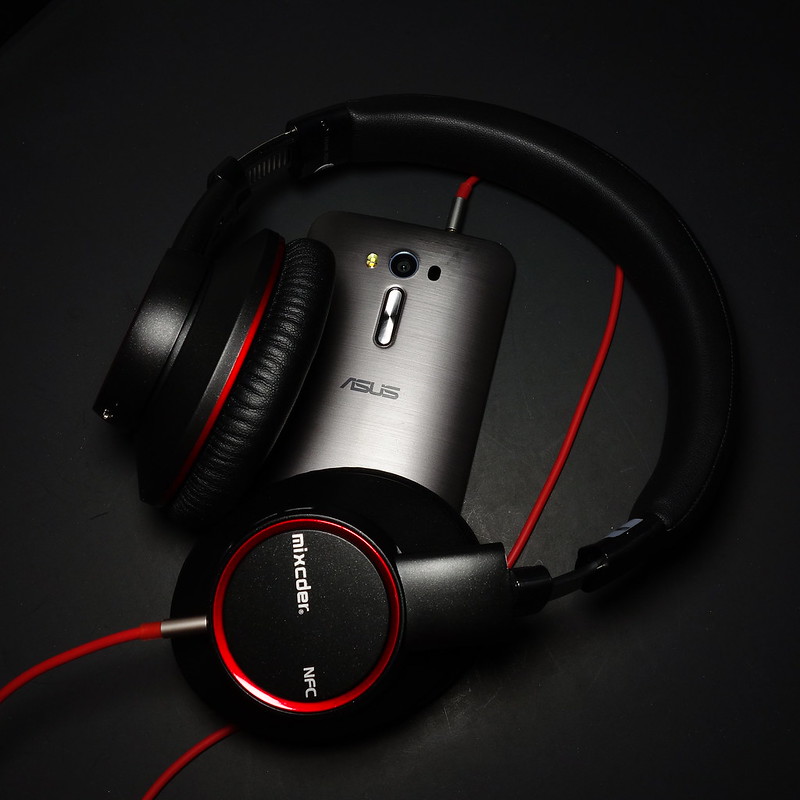
FIT & FINISH
There’s no escaping the plasticky feel overall for the HD601 but the construction does feel solid enough. It does however suffer from some creaking at the swivel points which is a problem that features prominently on Sony’s ZX770BN & 100ABN but unlike those two, I can’t actually induce creaking even with vigorous shaking once the HD601’s are worn. It’s only as I’m actually adjusting the swivel while worn that I hear the creaking.
The detents offer solid clicks and won’t slip from set points even after a session doing burpees. The buttons provide nice tactile feedback from the electronic switches and in the weeks I’ve been using them, I’ve not experienced any electronic glitches.
INITIAL CONCLUSION
While headphones (and devices) featuring Low Latency are slowly on the rise, there still are only but a handful as of the time of this review. Towards that end, the closest competitor to the HD601 is Avantree’s Audition Pro both in terms of features and price. I’d give the edge to the HD601 due to its cheaper price ($59.99 vs $79.99 on Amazon currently), the better build quality and passive noise isolation and last but most certainly not least, the less piercing high’s.
The Audition Pro does however have one major feature I wish the HD601 had and that is Multi-point support given I had intended to use it with both my PC and via my phone, however I have learned to live with the hack I listed in the Connectivity / Range section.
For those interested, here are the respective product pages for Mixcder’s HD601 & TR008:
HD 601: https://mixcder.com/Product/Qualcom...ep-Bass-Over-Ear-Wireless-Headphone-g068.html
TR008: https://mixcder.com/product_show.aspx?id=5
=======
FTC DISCLOSURE
The HD601 was provided by Mixcder for review.


